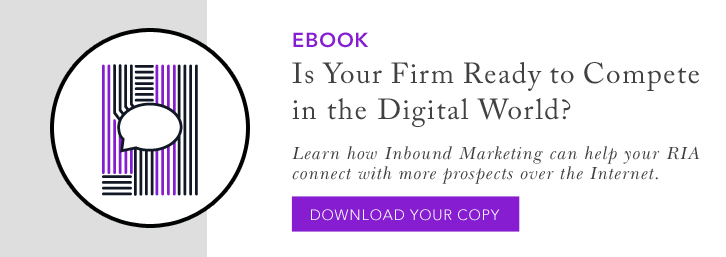What is a Chatbot and Why is it Now an Important Part of Financial Planning Marketing?
It’s almost 2019, and it’s crucial that your financial planning marketing plan evolves with the times.
One trend that financial advisors especially should no longer ignore is the use of chatbots. A chatbot can save a financial planning firm time and money, and more importantly, help turn leads into clients almost immediately.
What is a Chatbot?
The modern chatbot isn’t even 10 years old, but it’s already transforming financial planning marketing, customer relations and the overall user experience. If this is new to you, consider you’ve probably noticed those little windows in the lower right corner of more and more websites offering you the opportunity to chat with a representative now. If it’s during business hours, you may get a live person. But after hours, depending on the business, you may well be dealing with a chatbot. That is, a robot designed to handle basic inquiries and guide you through the sales or appointment generating process.
For investors, who often surf the web for information after hours at home, this has become a crucial tool for a financial planning marketing plan. It allows you to capture a lead when it’s hot, as opposed to waiting until the next business day to follow up or get them on your calendar.
If the idea of a chatbot is intimidating, remember, we’re already inviting sophisticated chatbots with artificial intelligence capabilities into our homes (Alexa) and into our pockets (Siri).
Today, chatbots are being utilized in tens of thousands of different contexts. And, of course, they are becoming routine on company websites in all kinds of different industries.
Messaging apps now dominate in the war for mobile users’ eyeballs, with 5 billion users every month, and account for 91% of time spent on Smartphones in the United States.
Chatbot usage is expected to continue to grow rapidly: Research from Market Research Future indicates that chatbots will grow by 37 percent per year from 2017 to 2023.
Natural language programming and artificial intelligence technology – first developed decades ago – have evolved exponentially in the last decade. And all indications are that customers are basically accepting chatbot usage as routine. Few customers have been turned off by reasonable chatbot usage, as long as it’s used to increase efficiency, convenience and access. And increasingly, customers are used to access to their financial information 24/7 – even at the smallest and most boutique firms. Financial planners who are still relying on old technology – or no technology – do so at their peril.
Chatbot Uses
Early on, financial industry firms used chatbots to generate automatic messages to users to notify them of activity on financial accounts. For example, a credit card issuer would create a chatbot to send an automated text message after every purchase, or in the event of suspicious activity on their accounts.
Firms also developed chatbots to take over the most basic customer-relations functions – handling frequently asked questions (“What time do you close?”) and basic keyword inquiries to direct calls to the right spot.
Bank of America recently rolled out “Erica” (Bank of AmERICA, get it?), to overwhelming success. The app allows customers to say “how much did I spend at QVC last month?” and get an instantaneous total, without having to touch a calculator. According to reports, “Erica” has been a huge hit.
Capital One also rolled out a chatbot, “Eno” (or “One” spelled backward), which has allowed customers to access balance and automated transaction history information just by sending a text. And TDAmeritrade leveraged voice recognition, natural language programming and artificial intelligence to create a full-fledged “assistant” named “Ted,” a “virtual investment consultant.” Ted represented a pretty big leap in chatbot technology and demonstrated that it was possible for a financial services company to automate much of the traditional fact-finding process. TDAmeritrade’s chatbot guides new customers through a series of questions to determine personal investing goals and risk tolerance, and even goes so far as to suggest a specific portfolio of investments, all within the space of about 15 minutes.
As a result, TDAmeritrade is able to profitably service much smaller accounts: Once the technology had been developed, they no longer had to pay a live body to collect this basic information. The additional onboarding cost of a customer filling out a fact-finder is essentially nil.
Financial planning marketing plans need to follow suit.
Segmentation
Chatbots can also be used for larger account balances that should be flagged for some extra TLC, as these accounts can be easily segmented for higher-touch services, where appropriate.
Chatbot technology is being rolled into so-called “robo advisors” that automate more and more routine and mundane aspects of the financial planning process, again, enabling financial service providers to expand their client bases to smaller accounts.
Furthermore, as services expand, chatbots can push messages to existing clients about new products and services and handle much of the onboarding process for upselling opportunities.
Evolving Usage
Today’s chatbots aren’t limited to handling basic inquiries about the office address. It’s now a relatively simple matter to have a chatbot handle a late-night prospect or customer inquiry all the way from a landing page to actually setting an appointment. The chatbot “sees” your calendar and your appointment availability, and customers can select from available timeslots.
From there, a chatbot can automatically generate a notification to you and insert the appointment into your calendar and the customer’s online calendar, if they have one. A chatbot can also automatically generate reminder notifications to the customer, all without any intervention from you or your staff.
The Chatbot Opportunity
Chatbots bring a number of potential advantages and opportunities to financial planners:
- 24/7 customer service and engagement. Customers demand the constant availability of basic data, such as balance/AUM information, transaction history and access to statements and tax documents. Chatbots can help you facilitate all of the above.
- Multi-tasking. Chatbots provide you and your staff the ability to handle multiple telephone and Internet inquiries at the same time without having to put anybody on hold.
- Scalability. Advisors can potentially take on a larger number of clients
- Staffing. Chatbots can free up staff and junior planners to handle more advanced levels of service.
- Fast qualification. It’s easy to use a chatbot to screen for qualified prospects – those meeting your required account minimums, for example, or those looking for the kinds of products and services you provide.
- Social media engagement. Today’s chatbots are readily integrated with Facebook and other social media platforms. So you can engage customers and prospects whether they come to you via a Google search or by following a link from a LinkedIn or Facebook platform.
- Lead conversion. Chatbots have proven to be effective at increasing lead conversion rates in a variety of industries. A recent survey conducted by Facebook found that customers are 50 percent more likely to buy from a brand after engaging with the company via chat – and that was true whether they were chatting with a live agent or a bot.
- A shortened loop: Chatbots can also send automated messages to a financial planner and/or his or her office manager, alerting them to a new lead and enabling immediate response.
- Savings. A Juniper Research report estimates that chatbots will save companies more than $8 billion per year, thanks to improved efficiency.
- Improved user experience. Customers can get immediate answers to frequently asked questions, and be quickly routed to the most appropriate representative for higher-complexity interactions requiring a human touch. Modern chatbots also “remember” customer issues, saving the customer the trouble of explaining their issue multiple times to different staffers as they are handed off from one department to the next.
What To Do Now
If you’re a financial planner who is still relying on old lead-qualification, appointment-setting and onboarding strategies, or if other firms are pulling ahead of you in terms of user experience and convenience, it’s probably time to upgrade.
While few financial planners have the expertise to develop more than the most basic chatbots (there are some tools available for Facebook Messenger, especially), Digital Marketing professionals such as those at Paladin Digital Marketing are aware of the best practices in chatbot design and implementation. Furthermore, Paladin’s expertise is focused specifically on the financial planning industry.
Contact Paladin Digital Marketing to find out how we can help give your customers and prospects a state-of-the-art experience – and help your practice succeed.


